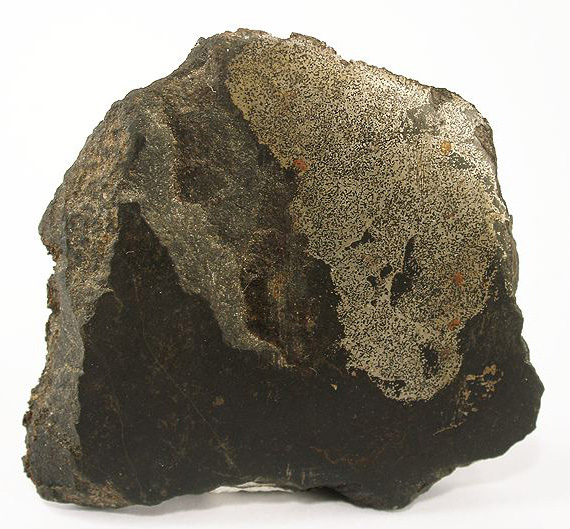The iron-nickel Mineral Group

Iron-nickel is technically a group of scientifically classified minerals. Most mineral collectors do not make a distinction between the individually-named minerals in this group, and refer to specimens as Iron or Iron-Nickel.
Most Iron-nickel is of extraterrestrial origin, in the form of meteorites. Hundreds of meteors fall toward earth every day, but most of them burn up in the atmosphere. The few that make it to earth usually land in water, and the few that land on the ground are generally small. Meteorites usually contain a crust, which forms when they are partially molten (from the heat generated by their speed) in the atmosphere, and solidify when they cool down by landing on earth.
There are some natural deposits of terrestrial Iron-nickel, but they are rare and limited. Crystals are uncommon, although some meteorites show etched crystals on polished faces, known as widmanstatten patterns.
Iron-nickel (terrestrial or extraterrestrial) develops a coating of rust if washed or if kept in a humid area. If a specimen must be washed with water, it should be thoroughly dried.
Click here for a detailed explanation on Iron-nickel in meteorites.
Chemical Formula
The Iron-Nickel group is composed of several minerals containing varying amounts of iron (Fe) and nickel (Ni). The individual member minerals are:
Iron - Fe
Kamacite - (Fe,Ni) - low crystallization form
Taenite - (Fe,Ni) - high crystallization form
Tetrataenite - FeNi
Awaruite - Ni2Fe to Ni3Fe
Nickel - Ni
Color
Steel-gray to black
Properties
Streak
Steel-gray. Streak shiny. |
Hardness
4 - 5 |
Transparency
Opaque |
Specific Gravity
7.9 - 8.9 |
Luster
Metallic |
Cleavage
None |
Fracture
Hackly |
Tenacity
Malleable and ductile |
Other ID Marks
1) Ferromagnetic.
2) Very good conductor of electricity. |
Additional Information
Composition
Iron - Native iron.
Kamacite - Alloy of iron and nickel, with a varying percentage of both elements.
Taenite - Alloy of iron and nickel, with a varying percentage of both elements.
Tetrataenite - Alloy of iron and nickel, with the ratio of iron molecules to nickel molecules 1:1.
Awaruite - Alloy of iron and nickel, with a ratio of iron to nickel between 2:1 and 3:1.
Nickel - Native nickel (usually with a small amount of iron). |
In Group
Native Elements; Metallic Elements |
Striking Features
Strong attraction to magnets, heaviness, and interesting crystal habits |
Environment
Most often in meteorites or meteorite impact sites and craters. In terrestrial environments in volcanic basalt formed by reduction of iron oxides in contact with carbonates. |
Rock Type
Igneous, Meteoric |
Uses
Terrestrial Iron-nickel is very rare. Iron-nickel Meteorites are also rare, but are far more common than terrestrial Iron-nickel. Because there is an abundance of iron and nickel compounds, Iron-nickel is not used as an ore of either iron or nickel.
Iron-nickel in all forms is valued as a rare collectors item, and meteorites are especially popular among collectors. There are collectors that specialize just in meteorites alone. Some meteorites are made into slabs or polished to display the etched Widmanstatten patterns. Meteorites are also used in scientific studies related to both geology and astronomy.
Noteworthy Localities
Iron-Nickel of extraterrestrial origins are found in random meteorite landing locations and craters on the earth. Some areas, such as the famous Barringer Crater (also known as Meteor Crater) in Coconino Co., Arizona, had been struck by a gigantic meteor in prehistoric times, which caused meteorite fragments to be scattered throughout the surrounding area.
Terrestrial Iron-nickel is found in only a few localities and very sparingly. Specific locations include Kassel, Germany; the Kola Peninsula, Russia; and Ovifak, Disco Island (Qeqertarsuaq), Greenland. Small waterworn nuggets were found in the Fraser River, near Lillooet, British Columbia, Canada, and in the Gorge river, New Zealand. Terrestrial Iron/Iron-nickel was also found in Josephine Co., Oregon; Smith River, Del Norte Co., California; Cameron, Clinton Co., Missouri; and St. Joseph's island in Lake Huron. Iron-nickel in the form of Taenite has been found sparingly at the Jeffrey Mine in Asbestos, Quebec, Canada.
Common Mineral Associations
Olivine
Distingushing Similar Minerals
Due to the interesting habits of Iron-nickel, few minerals are confused with it.